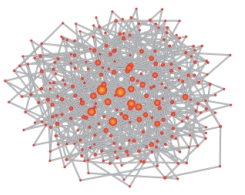Ecosystem networks
An ecosystem, just like any other network, is made up of various nodes and edges. Ecologists have long debated the relative importance of the type of partnerships, specialized or generalized, between the various organisms within the ecosystem. A specialized partnership can be visualized as two nodes that are connected to one another (or a few others at most) and nothing else whereas a generalized partnership would be made up of a node that is connected to many other nodes. By mapping out the network between animal pollinating agents and flowering plants, ecologists had actually discovered something interesting about the network structure within an ecosystem. In the study of pollinators and plants, there are pollinators that only feed on one plant and certain plants that only depend on one species of pollinators, thus forming a specialized partnership, while other pollinators and plants have generalized partnerships. It would seem intuitive that the more connected a plant is to different pollinators, the higher chance it had of surviving since its existence would not be solely dependent on one pollinator – and vice versa – in which case the extinction of that species would lead to extinction of the partner as well. Thus, ecologists had envisioned that the network would be an intricate web with each node connected to many other nodes.
However, it turns out that most plants and animals only form partnerships with a few other species. There were only a few generalist animals and plants that interacted with many other species. The network looked like individual components of specialists that were connected together by the few generalist species. This could be visualized as hubs forming around a highly-linked core of generalists.
It turns out that this phenomenon actually fosters more biodiversity and makes ecological networks better able to withstand crashes. Losing a single species is unlikely to bring the ecosystem down as because most species were only linked to a few other species. This could actually be explained through network theory. A network of hubs around a central core would contain many bridges. The removal of a node (a specialist) that formed the bridge would only result in that one hub becoming a new component, which in this case would most likely die off, but still allows for the rest of the network to be unaffected. The generalists also acts a safety net for the rest of the node as the presence of it may make the edge formed between the specialists to be a local bridge instead of just a bridge and thus prevent the hub from becoming a new component. However, too many generalists would only mean that a lot of nodes would be affected by the removal of one node since many edges would be removed which would be in the case of the intricate network model. This arrangement is not unique to this ecosystem and is pretty much the same from one ecosystem to another.
Source: http://e360.yale.edu/feature/network_theory_a_key_to_unraveling_how_nature_works/2233/


